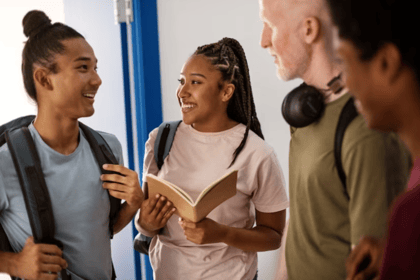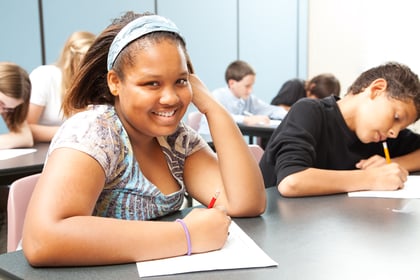The Importance of Embracing Diversity in the Classroom
 In a hyperconnected world, looking in any direction leads us to encounter diverse richness. The classroom is no exception. Our learners differ in terms of gender, culture, learning styles, modes of thinking, physical limitations or possibilities, disabilities, specific needs, and unique talents. Let's explore the educational benefits of diversity in the classroom in this profound analysis and discuss how embracing diversity in the educational environment can make a difference.
In a hyperconnected world, looking in any direction leads us to encounter diverse richness. The classroom is no exception. Our learners differ in terms of gender, culture, learning styles, modes of thinking, physical limitations or possibilities, disabilities, specific needs, and unique talents. Let's explore the educational benefits of diversity in the classroom in this profound analysis and discuss how embracing diversity in the educational environment can make a difference.
Join me on this four-chapter journey toward a broader understanding of the importance of inclusion and equity in education. From implications for academic performance to the development of social and emotional skills, we will examine the latest research supporting the creation of inclusive classrooms and their impact on students' growth and development. Prepare to discover how diversity can be a powerful tool for educational success and how we can harness it to benefit all students. Delve into this fascinating academic world and challenge your previous knowledge about the transformative power of diversity in the classroom.
To begin discussing the diversity that exists within today's classrooms, we must acknowledge that each student brings unique backgrounds, experiences, and learning needs. It is crucial for teachers to create an inclusive and equitable learning environment that responds to the complex universe of nuances encompassing diversity. This goes beyond differences in race, ethnicity, and cultural background. It encompasses variations in learning styles, abilities, interests, and experiences. By recognizing and celebrating these differences, we as teachers can create a rich and inclusive learning environment that benefits all students, embracing diversity and acknowledging its impact on students' learning and performance.
We should all know that diversity fosters a sense of belonging. When students see their own identities and experiences reflected in the classroom, they feel a sense of being in the right place and acceptance. This creates a positive emotional climate, improves self-esteem, and motivates students to actively participate in their learning.
But how can we promote empathy and understanding in a diverse classroom? Interaction with peers from different cultural backgrounds fosters empathy, tolerance, and appreciation for different perspectives. Students develop a deeper understanding of the world, promoting a more inclusive and respectful society beyond the classroom.
 In this educational path, we must focus on the present and the convergences and divergences to which students are exposed. We need to prepare our students to interact assertively in the world around them. In today's globalized society, it is normal for our students to interact with and in the future continue to connect with people from diverse backgrounds and individuals with different approaches to life. By experiencing diversity in the classroom, they develop effective communication, collaboration, and problem-solving skills in multicultural environments.
In this educational path, we must focus on the present and the convergences and divergences to which students are exposed. We need to prepare our students to interact assertively in the world around them. In today's globalized society, it is normal for our students to interact with and in the future continue to connect with people from diverse backgrounds and individuals with different approaches to life. By experiencing diversity in the classroom, they develop effective communication, collaboration, and problem-solving skills in multicultural environments.
Therefore, as teachers, we must ensure that we build an inclusive environment that can impact our students and instruct them to grow in tolerance, respect, equity, understanding, resilience, and justice.
To achieve this, we can start by supporting our students' academic performance through the design of safe and inclusive classroom environments that support individualized instruction, providing spaces where we as teachers can address the diverse learning needs of our students. Keep in mind that when we consider students' unique strengths and challenges, they are more likely to engage, be motivated, and achieve academic success.
Another strategy is to enhance critical thinking and creativity. Different perspectives and experiences enrich class discussions and promote critical thinking. Students who develop these skills learn to question assumptions, challenge stereotypes, and consider alternative viewpoints. This diversity of thought fosters creativity and innovation.
Working on social and emotional development is essential. It always has been, yet it was undervalued in the past. Inclusive classrooms foster positive relationships among students. In these spaces, students learn to respect and value each other's differences, contributing to a supportive and cooperative learning community. This environment promotes students' social and emotional development, leading to improved well-being and mental health.

Some ways in which we can make the most of diversity to enhance the classroom experience are:
- Co-creating cultural exchange spaces and global awareness with our students is essential in a diverse classroom.
Through these enriching experiences, our students have the opportunity to immerse themselves firsthand in different cultures, traditions, and languages. To achieve this, we can establish reading corners or cultural exhibitions within the classroom. Additionally, we can design interdisciplinary activities that promote the exploration of culture, geography, economics, nature, customs, and even dances and rhythms from diverse places.
An effective strategy is to involve students in question-and-answer dynamics where the group has the opportunity to ask questions about different cultures and face challenges related to geographical origins, religious differences, physical variations, or diverse experiences. These personal interactions, stories, and customs foster a sense of curiosity, respect, and global awareness in our students.
By providing an environment where diverse perspectives and experiences are valued and shared, we create a conducive atmosphere for our students to develop an open mindset and an appreciation for diversity. In doing so, we promote mutual understanding, empathy, and the building of bridges that transcend cultural barriers. Together, as committed educators, we can forge a generation of global citizens who are prepared to face challenges and embrace the opportunities of an increasingly interconnected world.
 Fostering collaborative learning is essential to make the most of diversity in the classroom. Collaborative projects that integrate group activities in diverse classrooms provide valuable opportunities for students to work together and leverage their unique strengths. As they collaborate, students learn to appreciate and value their peers' contributions, leading to improved teamwork and collaboration skills.
Fostering collaborative learning is essential to make the most of diversity in the classroom. Collaborative projects that integrate group activities in diverse classrooms provide valuable opportunities for students to work together and leverage their unique strengths. As they collaborate, students learn to appreciate and value their peers' contributions, leading to improved teamwork and collaboration skills.
One of the standout benefits of collaborative learning in a diverse environment is the ability to practice problem-solving from multiple perspectives. When faced with challenges and obstacles in teamwork, students are challenged to analyze and address situations from different angles, integrating diverse ideas and approaches to find comprehensive solutions. This integrative approach strengthens their ability to creatively and effectively solve problems.
Furthermore, diversity in the classroom stimulates creativity. The different perspectives and approaches brought by students with diverse backgrounds and experiences enrich discussions and generate diverse ideas, strategies, and solutions. This exchange of ideas fosters creativity, innovation, and critical thinking among students as they are exposed to new ways of addressing challenges and exploring alternatives.
Try in the classroom:
- Establish heterogeneous groups, ensuring that students are mixed to represent different perspectives, skills, and cultural backgrounds. This will encourage the exchange of diverse ideas and experiences.
- Set norms of respect and appreciation that promote an inclusive environment where all students feel valued and heard. Encourage students to appreciate and recognize the individual contributions of their peers.
- Promote effective communication by providing opportunities for students to practice skills such as active listening, expressing ideas clearly, and considering different perspectives.
- Provide adequate support and resources for students to work collaboratively. This can include clear guidelines for group work, technological tools, and appropriate physical spaces, among others.
- Encourage reflection on the collaborative learning experience and diversity in the classroom. Invite students to evaluate their own growth and development in terms of teamwork skills, critical thinking, and appreciation of diversity.
Embrace diversity in the classroom. It holds immense value for your students as it creates an inclusive environment where they feel valued, respected, and empowered to reach their full potential. Remember that the impact of an inclusive classroom goes beyond academic achievements, as it means preparing our students to thrive in a diverse world. By embracing diversity, teachers and the educational community leading the learning processes, as well as families, can enhance the classroom experience and equip our students with the necessary skills and understanding to succeed in an interconnected and multicultural society. What are you waiting for?